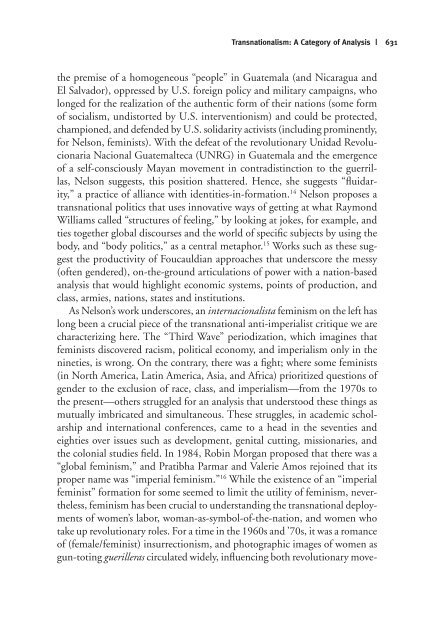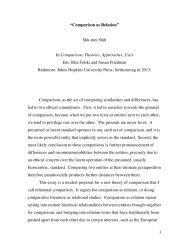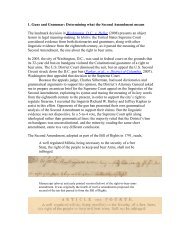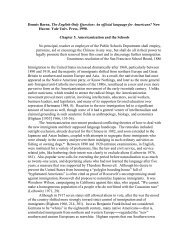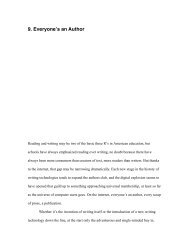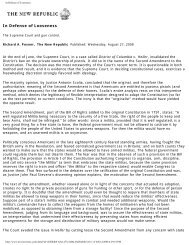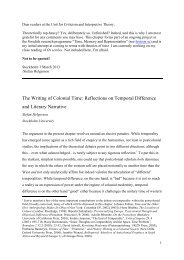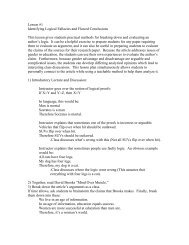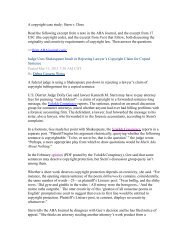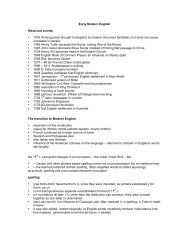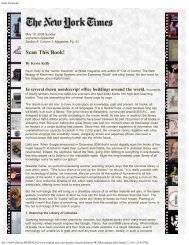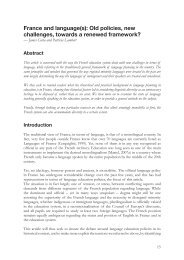Transnationalism: A Category of Analysis - Unit for Criticism and ...
Transnationalism: A Category of Analysis - Unit for Criticism and ...
Transnationalism: A Category of Analysis - Unit for Criticism and ...
Create successful ePaper yourself
Turn your PDF publications into a flip-book with our unique Google optimized e-Paper software.
<strong>Transnationalism</strong>: A <strong>Category</strong> <strong>of</strong> <strong>Analysis</strong> | 631<br />
the premise <strong>of</strong> a homogeneous “people” in Guatemala (<strong>and</strong> Nicaragua <strong>and</strong><br />
El Salvador), oppressed by U.S. <strong>for</strong>eign policy <strong>and</strong> military campaigns, who<br />
longed <strong>for</strong> the realization <strong>of</strong> the authentic <strong>for</strong>m <strong>of</strong> their nations (some <strong>for</strong>m<br />
<strong>of</strong> socialism, undistorted by U.S. interventionism) <strong>and</strong> could be protected,<br />
championed, <strong>and</strong> defended by U.S. solidarity activists (including prominently,<br />
<strong>for</strong> Nelson, feminists). With the defeat <strong>of</strong> the revolutionary Unidad Revolucionaria<br />
Nacional Guatemalteca (UNRG) in Guatemala <strong>and</strong> the emergence<br />
<strong>of</strong> a self-consciously Mayan movement in contradistinction to the guerrillas,<br />
Nelson suggests, this position shattered. Hence, she suggests “fluidarity,”<br />
a practice <strong>of</strong> alliance with identities-in-<strong>for</strong>mation. 14 Nelson proposes a<br />
transnational politics that uses innovative ways <strong>of</strong> getting at what Raymond<br />
Williams called “structures <strong>of</strong> feeling,” by looking at jokes, <strong>for</strong> example, <strong>and</strong><br />
ties together global discourses <strong>and</strong> the world <strong>of</strong> specific subjects by using the<br />
body, <strong>and</strong> “body politics,” as a central metaphor. 15 Works such as these suggest<br />
the productivity <strong>of</strong> Foucauldian approaches that underscore the messy<br />
(<strong>of</strong>ten gendered), on-the-ground articulations <strong>of</strong> power with a nation-based<br />
analysis that would highlight economic systems, points <strong>of</strong> production, <strong>and</strong><br />
class, armies, nations, states <strong>and</strong> institutions.<br />
As Nelson’s work underscores, an internacionalista feminism on the left has<br />
long been a crucial piece <strong>of</strong> the transnational anti-imperialist critique we are<br />
characterizing here. The “Third Wave” periodization, which imagines that<br />
feminists discovered racism, political economy, <strong>and</strong> imperialism only in the<br />
nineties, is wrong. On the contrary, there was a fight; where some feminists<br />
(in North America, Latin America, Asia, <strong>and</strong> Africa) prioritized questions <strong>of</strong><br />
gender to the exclusion <strong>of</strong> race, class, <strong>and</strong> imperialism—from the 1970s to<br />
the present—others struggled <strong>for</strong> an analysis that understood these things as<br />
mutually imbricated <strong>and</strong> simultaneous. These struggles, in academic scholarship<br />
<strong>and</strong> international conferences, came to a head in the seventies <strong>and</strong><br />
eighties over issues such as development, genital cutting, missionaries, <strong>and</strong><br />
the colonial studies field. In 1984, Robin Morgan proposed that there was a<br />
“global feminism,” <strong>and</strong> Pratibha Parmar <strong>and</strong> Valerie Amos rejoined that its<br />
proper name was “imperial feminism.” 16 While the existence <strong>of</strong> an “imperial<br />
feminist” <strong>for</strong>mation <strong>for</strong> some seemed to limit the utility <strong>of</strong> feminism, nevertheless,<br />
feminism has been crucial to underst<strong>and</strong>ing the transnational deployments<br />
<strong>of</strong> women’s labor, woman-as-symbol-<strong>of</strong>-the-nation, <strong>and</strong> women who<br />
take up revolutionary roles. For a time in the 1960s <strong>and</strong> ’70s, it was a romance<br />
<strong>of</strong> (female/feminist) insurrectionism, <strong>and</strong> photographic images <strong>of</strong> women as<br />
gun-toting guerilleras circulated widely, influencing both revolutionary move-


